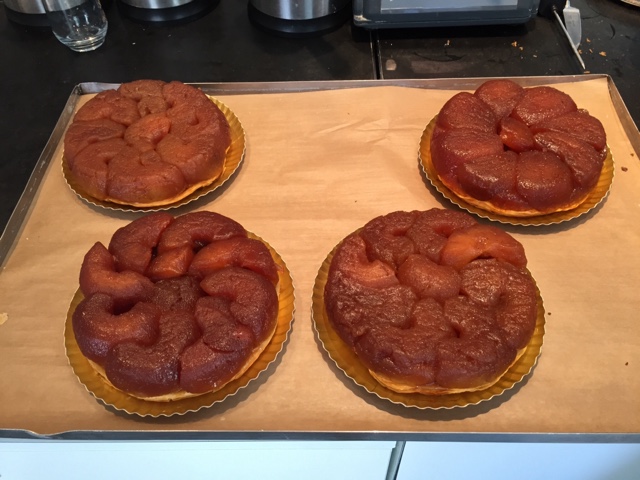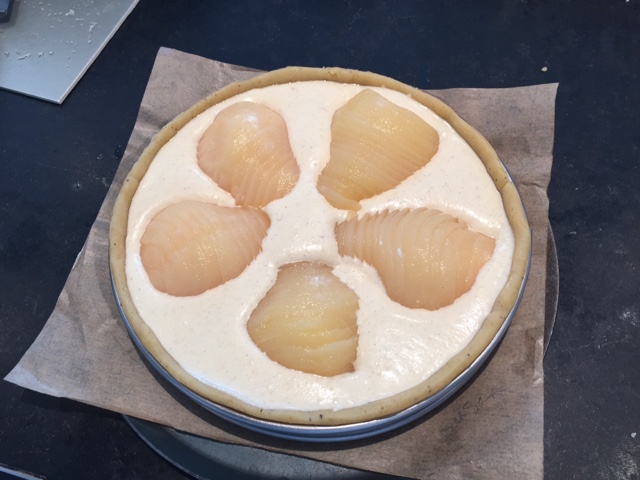Tarte Tatin
/Before I jump into the topic at hand I'd like to share a photo of this gorgeous maple tree that we've been viewing from our window every day these past few weeks. It's a beauty!

Making a classic tarte tatin has been on my to-do list for some time now. So when a recent NYT article with the tatin recipe from Gotham Bar and Grill was published online, I felt it was time.
Over the years I've tried my hand at a couple of variations, one being a few summers ago when I made petite versions in mini muffin pans with plums and peaches. They were messy but deeeelicious. More recently, a second attempt involving a mango version from Christophe Felder's book Les Folles Tartes, turned out OK, but something about the flavor of the mangoes put me off.
As is my wont, when I'm planning to make a classic of anything, I compare a number of recipes to see how different chefs approach the process.

In addition to Felder's I reviewed recipes from Dorie Greenspan, Michel Roux, Philippe Conticini, Sherry Yard, Francois Payard and the above mentioned Gotham B&G. Each had a slightly different take on the process.
The recommended apples ran the gamut from Golden Delicious, Gala, Braeburn, Granny Smith, Cox and Honeycrisp, typically requiring 6-8 apples for a 9-10" tart. I opted for a mixture of Braeburn and Granny Smith, partly because I had never baked with Braeburns and thought it a good test. I like G. Smith because they hold their shape, and their tartness goes so well with buttery pastry and caramel.

Most recipes call for pâte feuilletée (puff pastry), although a couple used pâte brisée.
Sherry Yard likes to use croissant dough as her tart base. Go figure. The quantity of dough is generally about 8 ounces. This is another one of those times when it's great to have some puff pastry already made and in your freezer!
Typically sugar and butter (amounts vary from recipe to recipe) are used to create a caramel. Some variations involve making the caramel, pouring it into a moule à manqué (cake pan) and temporarily setting it aside. The prepped apples are then placed over the cooled caramel and baked in a 350-375 oven for perhaps 30 minutes to soften and caramelize them. They are then topped with a round of pastry and placed back in the oven to continue the caramelization and bake the pastry until golden brown.
Alternatively some recipes have you bake the pastry round separately and then place it onto the baked apples. The whole thing is then turned out onto a platter before serving.
After a while all these variables become a bit overwhelming. I decided to go the classic route, starting on the stove top and then moving into the oven. I followed the guidelines in Dorie Greenspan's "Paris Sweets" recipe, although I did not make the vanilla tea version as she does.
First I rolled out my puff pastry to about 3 mm thick, and using a cake circle as a guide, cut a round slightly larger than my pan. I pricked it with a fork, covered it and held it in the fridge until later. Interestingly, both Michel Roux and Gotham B&G have you put the raw pastry over the apples while still on the stovetop before even going into the oven. To each his own.


Then I took my new 10" Lodge cast iron pan (can't believe it took me so long to buy one!), coated it in 113 gm (4 oz) soft butter and sprinkled 150 gm of sugar over it. I used a mixture of my own vanilla sugar and granulated sugar.



I had peeled, cored and quartered a total of 6 apples . . . .

which I layered over the butter/sugar:

The pan is placed over medium heat on the stovetop until a light to medium caramel develops. The time for that will vary, and one must keep on eye on things and adjust the heat as needed to prevent burning.


Here is where one must use judgement about the extent of the caramelization. I thought this was looking nicely ready so I retrieved my pastry from the fridge and placed it over the apples:

Recommended baking temperatures ran from 350-375ºF and baking times varied from 30-50 minutes with the ultimate goal being a nicely browned pastry. I baked mine at 375 for about 35 minutes and thought it had achieved just that very look:

I gave it just a minute or two to let any bubbling subside, then, placing a flat platter over the pan, handily flipped the tart out with nary a hitch (I was a bit worried as to how I would fare with that step). Imagine my disappointment when I saw before me a much paler version than what I had anticipated! Plus the Braeburn apples, while actually still holding some shape, were on the verge of mushy applesauce!!

Even the edge of the pastry looked underdone, and I dreaded biting into a doughy mouthful (the worst).

But have no fear. Steve arrived home soon after the tart came out of the oven and said "why don't you put it back in?" So I slipped the whole thing back onto a parchment lined sheet pan, apple side up and baked it for a good 30 minutes more. The fix was in . . .


Check out the caramelized pastry now!
Lesson learned. Next time I would let the caramel on the stove top go a tad further and would definitely extend the baking time to a decent 50-60 minutes. Since one can't see what's going on with the apples underneath the pastry, it takes practice to understand the timing of it all. Other than that I found the whole thing really very straight forward and wondered why I hadn't made this long ago.
In preparation for this tarte tatin I had made a classic vanilla bean crème anglaise ice cream base the day before which had spent the night chilling in the fridge. I processed it in my good old Cuisinart canister model ice cream maker and held it in the freezer until serving.


Nothing fancy . . .

but delicious and well worth it!
Yes, I would definitely make this again.










